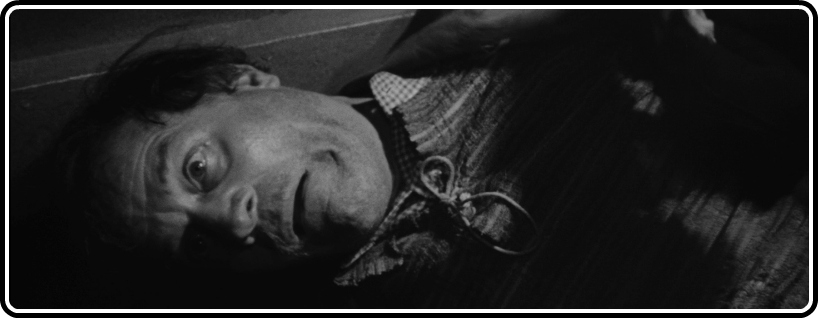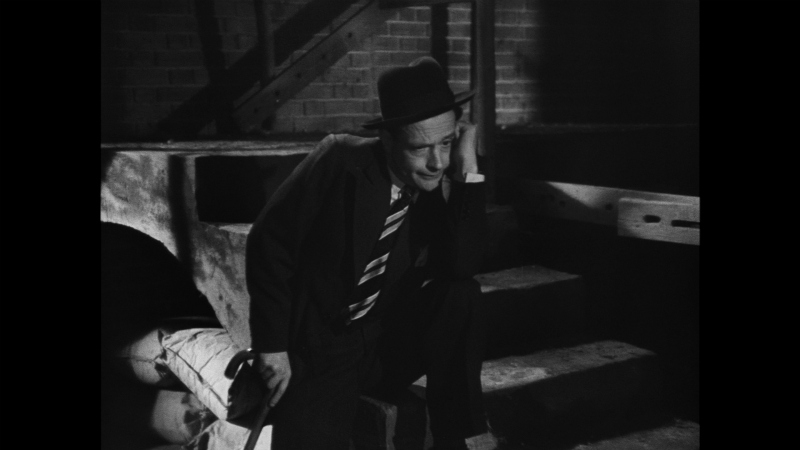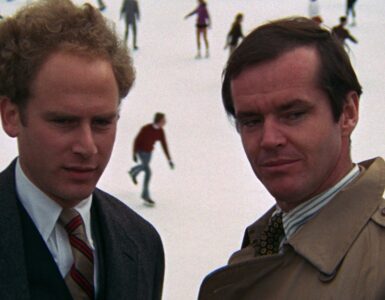
Not to make this all about me, but on the long list of films I’ve written about, The Murderer Lives at 21 was damn near the bottom in ones I expected to ever revisit, which is especially ironic considering I apparently knew at the time that it was due for a Gaumont restoration, thus a Blu-ray, and thus at least stood a chance of hitting my proverbial desk at some point down the line. Well, that restoration has taken place, a Blu-ray has indeed been produced, and I’ll be damned if I didn’t get sucked into it all over again. I put this on with the exclusive intention of reminding myself of the characters and story points, but was very quickly sucked into its economic, lively, and twist-filled story, but most especially its two protagonists, Inspector Wenceslas Vorobechik (“Wens,” for short, played by Pierre Fresnay) and his girlfriend, Suzy Delair (Mila Malou), as they both attempt to catch the mysterious Monsieur Durand, a serial-killer-slash-petty-thief who leaves his calling card upon his victims’ bodies.
You may refer to that earlier piece for some valuable contextualization, as the film was one of a few dozen made under Nazi occupation during World War II, which left Clouzot beholden to any number of requirements that he was somewhat indebted to satisfy. As such, there is a sense of a manufactured product throughout the film, even more so than with your typical murder mystery, but I hasten to say that detracts very little from the total enjoyment of the picture, which was greatly heightened in revisiting it this week. Wens and Suzy have real, palpable chemistry reminiscent of the American screwball comedies and especially the Thin Man films, but Murderer does far more than fill a gap left by the then-banned American productions. More than pure imitation, there’s a particularly French flavor to this, as Wens and Suzy’s relationship has a much greater tension than we might see in similar American affairs, which would necessitate they be married.

By having them be unmarried, but closely-linked, they are each beholden to separate, but no less urgent, professional duties (Suzy’s hoping to catch the killer to get her name in the paper, and thus land gigs as a famous singer) that cannot be merely dismissed because of her relationship with a man in a much more stable profession. Should he choose to up and leave her, she’d really be in dire straits. The stakes aren’t quite life-or-death for either of them – each would be out of a job, but seem to be getting along all right – but just vital enough to keep things lively. Malou in particular is really extraordinary, enormously appealing without being overtly sexy or traditionally attractive, but never in a way that could be perceived to be off-putting. She’s just a ball of boundless energy, eager to direct it towards the most good, but equally satisfied just to get on Wens’ nerves, knowing that to be the key to his heart. She expresses total devotion through a certain attitude that could be understood as annoyance, but which, most touchingly, Wens receives wholeheartedly.
That it’s all layered on top of what emerges to be a genuinely involving murder mystery, and shot with that beautiful, sculpted-shadow atmosphere that cinematographer Armand Thirard would bring to Clouzot’s Diabolique and Wages of Fear, it really makes for a hell of an 80-some minutes.

Making that 80-some minutes go down much more smoothly is Masters of Cinema’s spiffy new (Region-B locked) Blu-ray release. If you click over to the aforementioned piece, you’ll note that the presentation on Criterion’s Hulu channel was, well, kind of dreadful. Easily the worst I’ve yet encountered on that service. While MoC’s transfer of Gaumont’s restoration would’ve be revelatory purely on its own terms, as a point of comparison it’s almost revolutionary! But wherever one’s coming at this, you’d have to just flat-out make things up to complain. A few of the wider shots lose some clarity, but that could be a source issue; the rest of the transfer is nicely – but not overly – crisp, with plenty of grain and really outstanding contrast. The image isn’t over-sharpened to make it “pop,” but the blacks are so deep and rich you almost feel you could get gently coaxed into being swallowed whole. Fitting, indeed. The sound is as rich and layered as these earlier productions are likely to be, which, for me, is a compliment.
Special features are limited to a conversation with Ginette Vincendeau (on the disc), in which she explores the various themes and motifs in the film, as well as a booklet that’s heavy on historical context, courtesy of excerpts from books by Judith Mayne and Christopher Lloyd (not that one, I assume), as well as snippets from interviews with Clouzot. All three do address dramatic and aesthetic concerns, but the focus is more historical than Vincendeau’s analysis.
It’s not a mind-blowing release, but it’s very solid, and the film held up a lot better on rewatching it than I expected it to, so it is well worth adding to one’s library. If your exposure to Clouzot is limited to his more self-serious affairs to come, this will provide some welcome diversity and perspective, as it turns out he could do light entertainment as well as, if not better than, just about anyone. It may have been designed as escapism, but I’ll be damned if it didn’t work. Check out the extraordinarily enticing opening scene below for a taste.




![Bergman Island (The Criterion Collection) [Blu-ray]](https://criterioncast.com/wp-content/uploads/2022/11/bergman-island-the-criterion-collection-blu-ray-400x496.jpg)
![This Is Not a Burial, It’s a Resurrection (The Criterion Collection) [Blu-ray]](https://criterioncast.com/wp-content/uploads/2022/11/this-is-not-a-burial-its-a-resurrection-the-criterion-collection-blu-ray-400x496.jpg)
![Lars von Trier's Europe Trilogy (The Criterion Collection) [The Element of Crime/Epidemic/Europa] [Blu-ray]](https://criterioncast.com/wp-content/uploads/2022/11/lars-von-triers-europe-trilogy-the-criterion-collection-the-element-of-400x496.jpg)
![Imitation of Life (The Criterion Collection) [Blu-ray]](https://criterioncast.com/wp-content/uploads/2022/11/imitation-of-life-the-criterion-collection-blu-ray-400x496.jpg)
![The Adventures of Baron Munchausen (The Criterion Collection) [4K UHD]](https://criterioncast.com/wp-content/uploads/2022/11/the-adventures-of-baron-munchausen-the-criterion-collection-4k-uhd-400x496.jpg)
![Cooley High [Criterion Collection] [Blu-ray] [1975]](https://criterioncast.com/wp-content/uploads/2022/11/cooley-high-criterion-collection-blu-ray-1975-400x496.jpg)